|
|
|
Sort Order |
|
|
|
Items / Page
|
|
|
|
|
|
|
| Srl | Item |
| 1 |
ID:
088202
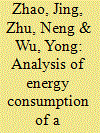

|
|
|
|
|
| Publication |
2009.
|
| Summary/Abstract |
According to statistics and field investigation, the energy consumption situation and reality of commercial building is described in this paper. As the first step of large-scale public building energy efficiency supervision system encouraged by central government of China, the energy consumption of several typical commercial buildings and public buildings was analyzed in detail. The main contents of investigation are as follows: basic information of building, operational record of energy consumption equipment, energy consumption of indoor equipments, energy-efficiency assessment of energy consumption systems and equipments, investigation of behavior energy saving, etc. On this basis further analysis and diagnosis including indoor thermal and humid environment, operation state of air-conditioning water system, operation state of air-conditioning duct system and operation management of air-conditioning system were implemented. The results show that the most energy consumption of buildings in this city is commercial buildings, which can reach to about 240 W/m2 per year. Further analysis tells that air conditioning systems play the major role of building energy consumption, and building energy saving has great potential in this city. In this paper, the ways of diagnosis work for building energy consumption are also described and discussed. Reasonable test, diagnosis and analysis are meaningful for building energy efficiency retrofit and management.
|
|
|
|
|
|
|
|
|
|
|
|
|
|
|
|
| 2 |
ID:
088208
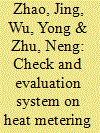

|
|
|
|
|
| Publication |
2009.
|
| Summary/Abstract |
Heat metering and energy efficiency retrofit of existing residential buildings in northern heating areas of China is organized and implemented in a large scale by local government in 15 provinces of North China with the unified guidance and control of central government. Firstly, this paper introduced the target of energy-saving reformation of existing residential buildings in North China and the importance of check and evaluation on this target, then pointed out the necessity of building up an evaluation system for energy-saving retrofit. According to the analytical hierarchy process (AHP), three-grade evaluation system was built up for heat metering and energy efficiency retrofit of existing residential buildings in northern heating areas of China. Also, based on multi-index comprehensive evaluation method combined with life cycle assessment (LCA) theory, post-evaluation thought and successful degree evaluation method, a mathematical model was established. Finally, a set of scientific method for evaluating heat metering and energy efficiency retrofit of existing residential buildings in northern heating areas of China systematically, scientifically, comprehensively and objectively was created.
|
|
|
|
|
|
|
|
|
|
|
|
|
|
|
|
| 3 |
ID:
088198
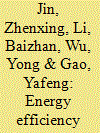

|
|
|
|
|
| Publication |
2009.
|
| Summary/Abstract |
This paper discusses energy consumption, building development and building energy consumption in China, and points that energy efficiency management and maintenance of large-scale public buildings is the breakthrough point of building energy saving in China. Three obstacles are lack of basic statistics data, lack of service market for building energy saving, and lack of effective management measures account for the necessity of energy efficiency supervision for large-scale public buildings. And then the paper introduces the supervision aims, the supervision system and the five basic systems' role in the supervision system, and analyzes the working mechanism of the five basic systems. The energy efficiency supervision system of large-scale public buildings takes energy consumption statistics as a data basis, Energy auditing as a technical support, energy consumption ration as a benchmark of energy saving and price increase beyond ration as a price lever, and energy efficiency public-noticing as an amplifier. The supervision system promotes energy efficiency operation and maintenance of large-scale public building, and drives a comprehensive building energy saving in China.
|
|
|
|
|
|
|
|
|
|
|
|
|
|
|
|
| 4 |
ID:
088199
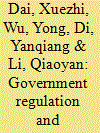

|
|
|
|
|
| Publication |
2008-09.
|
| Summary/Abstract |
The supervision of energy efficiency in government office buildings and large-scale public buildings is the main embodiment for government implementation of Public Administration in the fields of resource saving and environmental protection. Aimed at improving the current situation of lack of government administration in building energy efficiency, this paper proposes the concept of "change and redesign of governmental supervision in building energy efficiency", repositioning the role of government supervision. Based on this theory and other related theories in regulation economic and modern management, this paper analyzes and researches the action and function of all level governments in execution of the supervisory system of building energy efficiency in government office buildings and large-scale public buildings. This paper also defines the importance of government supervision in energy-efficiency system. Finally, this paper analyzes and researches the interaction mechanism between government and owners of different type buildings, government and energy-efficiency service institution with gambling as main features. This paper also presents some measurements to achieve a common benefit community in implementation of building energy-efficiency supervisory system.
|
|
|
|
|
|
|
|
|
|
|
|
|
|
|
|
| 5 |
ID:
088200
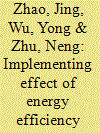

|
|
|
|
|
| Publication |
2008-09.
|
| Summary/Abstract |
The Chinese central government released a document to initiate a task of energy efficiency supervision system construction for government office buildings and large-scale public buildings in 2007, which marks the overall start of existing buildings energy efficiency management in China with the government office buildings and large-scale public buildings as a breakthrough. This paper focused on the implementing effect in the demonstration region all over China for less than one year, firstly introduced the target and path of energy efficiency supervision system, then described the achievements and problems during the implementing process in the first demonstration provinces and cities. A certain data from the energy efficiency public notice in some typical demonstration provinces and cities were analyzed statistically. It can be concluded that different functional buildings have different energy consumption and the average energy consumption of large-scale public buildings is too high in China compared with the common public buildings and residential buildings. The obstacles need to be overcome afterward were summarized and the prospects for the future work were also put forward in the end.
|
|
|
|
|
|
|
|
|
|
|
|
|
|
|
|
| 6 |
ID:
111367


|
|
|
|
|
| Publication |
2012.
|
| Summary/Abstract |
With the increasing building energy consumption, the improvement of building energy efficiency (BEE) becomes a key part of the reduction of energy intensity in the "Eleventh Five-Year Plan" period (during 2006 and 2010) in China. For this reason, the China central government has enforced and implemented a series of policies to promote BEE. Based on the analysis of main characteristics of BEE development in China and developmental routes of BEE, this paper systematically explored six fiscal incentive policies. Meanwhile, four specific programs involving new building, existing residential building, government office building and large-scale public building, and applications of renewable energy in building were investigated. Besides, the key factors of BEE development and BEE developmental stages were analyzed. The research revealed the present progress of implementation on BEE policies, and identified the drawbacks of the present BEE mechanism. Moreover, four proposals were recommended to enhance the development of BEE in the next "Five-Year Plan" period.
|
|
|
|
|
|
|
|
|
|
|
|
|
|
|
|
| 7 |
ID:
088205
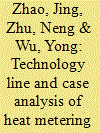

|
|
|
|
|
| Publication |
2009.
|
| Summary/Abstract |
The building area in northern heating areas accounting for 70% of the total land area in China is 6,500,000,000 m2. The average heating energy consumption in northern China is 100-200% times more than developed countries in the same latitude. This paper introduced firstly the heat metering and energy efficiency retrofit background of existing residential buildings in northern heating areas of China organized by mohurd and MOF, and then put forward the total principle and contents of retrofit. Through analyzing some retrofit cases in Germany, Poland and China, some technological experiences were summarized and finally a technology line suitable for heat metering and energy efficiency retrofit of existing residential buildings in northern heating areas of China which involved retrofit for heat metering and temperature regulation of heating systems, heat balance of heat source and network, and building envelope was described to provide a systematic, scientific, technological guide for the retrofit projects of 0.15 billion m2 in "the Eleventh Five-Year Plan" period.
|
|
|
|
|
|
|
|
|
|
|
|
|
|
|
|
|
|
|
|
|